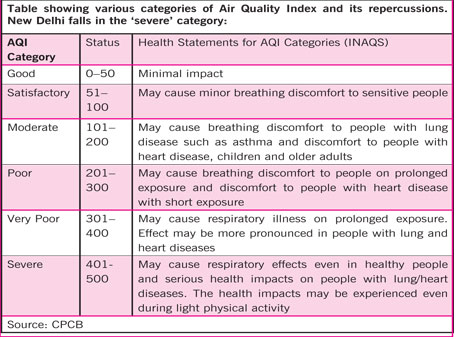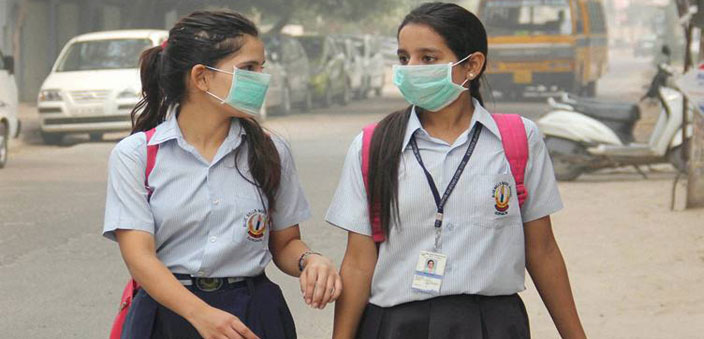Ilove my Bharat, but I lament at the state of the environment that we have begun to accept today. The capital city of New Delhi, every year is engulfedin fog, much worsened this year with the rising particulate matter, and extensive carbon presence in the air, making the air unbreatheable. The figures provided by the various agencies that matter have indicated an air quality index of 497 (Times of India, 6 November 2016), and a visibility of less than 500 meters for 13 hours at the Indira Gandhi International Airport (Times of India, 6 November 2016).
The media highlighted how the residents have been exposed to equivalent of 20 cigarette sticks per day. Unthinkable, how we survive in cities of modern Bharat. The Central Pollution Control Board has created a new set of Indian National Air Quality Standards (INAQS) for 12 parameters – carbon monoxide (CO) nitrogen dioxide (NO2), sulphur dioxide (SO2), particulate matter (PM) of less than 2.5 microns size (PM2.5), PM of less than 10 microns size (PM10), Ozone (O3), Lead (Pb), Ammonia (NH3), Benzo(a) Pyrene (BaP), Benzene (C6H6), Arsenic (As), and Nickel (Ni)] . The air quality index is drawn from them. The present count of the AQI in Delhi falls in the severe category, and warrants some stringent measures to be adopted by the governments and the civic bodies. (See Table)

There are a few requisite measures that have been lined up to handle the health emergency of the capital city. Vehicular restrictions, wet mechanised vacuum sweeping of the roads, reservations against the brick kilns, municipal garbage burning alerts, stopping constructions and demolition activities temporarily to be adopted as an immediate measure to curb the emissions.
Long term measures
A series of long term measures to tackle the problem have been outlined, such as installation of a remote sensor based PUC system, green vehicles, relining roads to avoid dust and biomethanisation of the dump yards. Interestingly, Delhi has always been foggy in the winter mornings, and flight delays have been a recurring feature for an early morning entry or an exit from the city. It is a meteorological condition and unavoidable. To manage the existing fog, some of the older, planned and colonial Delhi flaunts a lush, green foliage. However, the increased instances of heavy polluted trapped smog are increasingly becoming a problem for the city and the country as a whole.
The reason for this dense smog emanates from the rampant and unplanned urban development, and a genuine lack of vision by the planners to foresee the population needs. There is a mix of pollution from human and natural causes which may be responsible for the magnitude of the phenomena. Vehicular emissions, construction work, both domestic and commercial, resident fuel burning and municipal waste burnings to name a few. Delhi has the highest municipal waste collected in India, and the disposal area may emit or ignite pollutants occasionally. Another important contributor of the pollution has also been the winds from west – Afghanistan and Pakistan – which pick up as they move over the densely urbanised regions of Punjab and Haryana where farmers burn the straw in their fields, and this pollutes Delhi. Natural reason for Delhi’s fog too needs to be taken into account, as the western disturbances may lead to a sudden reversal of winds from dry and cold to humid easterlies causing the fog.
Let’s not forget, as per Census 2011, Delhi has a population of 1.68 crores, an increase from a figure of 1.39 crore as per 2001 census. The number of vehicles has increased manifold and the size of the NCR (National Capital Region) is on the increase. All this paints a grim picture of the future of a city with distinct political and historical roots. The governments both state and central have long passed the responsibility and the people have shrugged their own livable status. Delhi has been systematically pushed to the ‘limits’ of urbanisation with no one willing to muster the courage to change the course towards sustainability. Citizen responsibility in restricting the polluting festivals, consumptions and pushing for accountability of the civic bodies would perhaps ensure that phases like these don’t make the city despicable. At the heart of all development is the rights of the people to live and breathe just as there are rights to clean air and water. Long forgotten are the picture perfect urban colonies that were a legacy of the British and what has emerged are the colonies of misery and ill health. The limits to growth, as the famous essay of environmentalism has re-sounded would need to apply to cities bursting at the seams with the pressure of development. The hope to see cleaner cities still linger as the following lines would impress:
“The last thought we wish to offer is that man must explore himself – his goals and values – as much as the world he seeks to change. The dedication to both tasks must be unending. The crux of the matter is not only whether the human species will survive, but even more whether it can survive without falling into a state of worthless existence”:
Essay on Limits to Growth, Club of Rome (an international think-tank) 1968.


